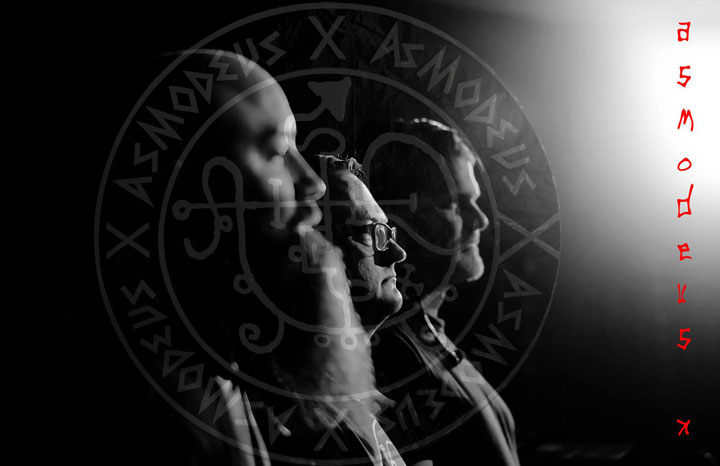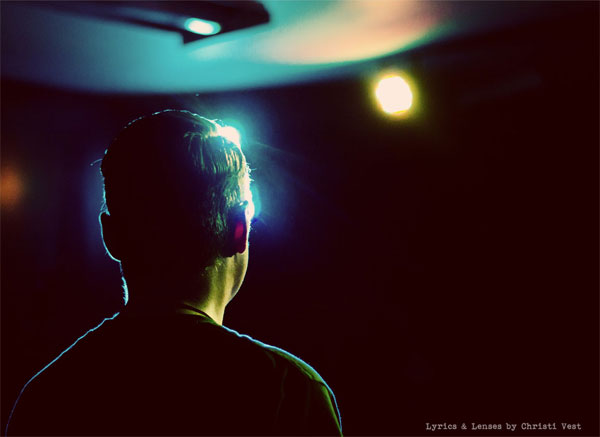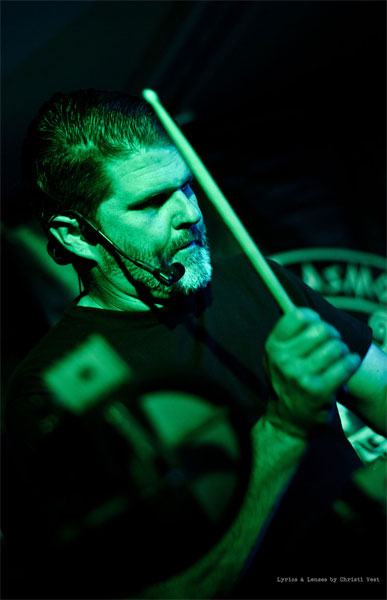
You can support Terra Relicta by donating! Please, do so, and thank you!

Interview with: Paul Fredric
Conducted by: Ines
 Asmodeus X. A name that strikes you and speaks to you, doesn't it? With a memorable name and a unique musical style, giving the classical darkwave meets EBM more of a cosmic and even psychedelic touch, this Houston, Texas based ensemble has been present in the scene since 1999 and have released six full length studio albums up to this day. The band, which draws influence from Slovenian industrial legends Laibach, as well as the big names you all ought to know well, such as Kraftwerk and Death In June, has so much history and stories behind its name, I simply won't lose any more words and just leave you to the words of Paul Fredric, who really poured his efforts into our conversation and gave us a very detailed and intimate view into Asmodeus X as well as himself as an artist.
Asmodeus X. A name that strikes you and speaks to you, doesn't it? With a memorable name and a unique musical style, giving the classical darkwave meets EBM more of a cosmic and even psychedelic touch, this Houston, Texas based ensemble has been present in the scene since 1999 and have released six full length studio albums up to this day. The band, which draws influence from Slovenian industrial legends Laibach, as well as the big names you all ought to know well, such as Kraftwerk and Death In June, has so much history and stories behind its name, I simply won't lose any more words and just leave you to the words of Paul Fredric, who really poured his efforts into our conversation and gave us a very detailed and intimate view into Asmodeus X as well as himself as an artist.
Ines: Hello Paul and thank you for doing this interview with our webzine, it was a pleasure and a pleasant surprise to getting to know Asmodeus X. The band was founded way back in 1999, but I want to go even further to the past - could you give us some words about your music history before Asmodeus X was born?
Paul: I cannot remember a time when music was not a part of my life. My father was blind and so that alone probably started me down the 'auditory path' early on, and he was always a great source of encouragement and inspiration. He gave me my first acoustic guitar when I was 5, and I started to learn it by trying to play along with Hank Williams and Elvis Presley records. Then in Elementary School I signed up for orchestra. When we were choosing what instrument to play I wanted to play the cello. With each instrument we'd raise our hands and the teacher would put us down on the list. She didn't see my hand when I raised it for cello, and I was too shy to say anything so I just rose for the next thing which happened to be the viola. So that's how I ended up playing viola throughout childhood, and also why I always get a little choked up when I hear the cello. Makes you think about destiny and fate. Through all of this my father was the one who supported me, encouraged me, took me to lessons, and so forth. He died when I was 10 years old and I stopped doing music at that time. When I was 16 I was getting into the new music that was going around then, which was a lot of post-punk and industrial type stuff like Joy Division, Bauhaus, Throbbing Gristle/PTV, Neubauten, SPK, Laibach; and got myself an electric guitar. There wasn't a lot going on in the small Midwest town of Lincoln, Nebraska, but there was enough interest in these sorts of indie things that there were all-ages shows and indie record stores. I started my first band One Dark Rabbit when I was in High School and we played shows around town and recorded an album on a 4 track recorder - that was my first recording experience and probably where I first fell in love with the production side of things. At some point in the late eighties I crossed over into playing the bass, with a punk band called Red Max. It was fun and high energy, and I learned the basics of gigging via regional touring, and I got to share stages with very early incarnations of 311 and Helmet, but ultimately found the whole thing unmeritous from a production/creative standpoint. I took a little break from music there, and tried to live a 'straight' life, but like always something eventually called me back. So in the mid 90's I started playing with Johnny Lee in the gothic group that would eventually become Morphine Angel, and this is probably where the past starts to slightly resemble the present. Here I played bass and also programmed the drum machine and started to get more  interested in electronics in general. With Morphine Angel a much larger world opened up and we released a CD, toured internationally, signed a record deal, moved to the 'big city,' got corrupted by decadence, exploited by managers, all the great things bands are supposed to do including ending in a maelstrom of heated emotion. A lot of the ideas that we started Asmodeus X out with were based on lessons learned and perceived mistakes from these sorts of experiences with Morphine Angel. Bands just starting out tend to just have that 'Four Blokes Against the World' mentality, and don't even imagine the sorts of problems that can arise once you sign a contract or agree to have someone else manage your money. But with Morphine Angel I learned what can be done with the right people connected with the right aim - in those moments our fire was unstoppable.
interested in electronics in general. With Morphine Angel a much larger world opened up and we released a CD, toured internationally, signed a record deal, moved to the 'big city,' got corrupted by decadence, exploited by managers, all the great things bands are supposed to do including ending in a maelstrom of heated emotion. A lot of the ideas that we started Asmodeus X out with were based on lessons learned and perceived mistakes from these sorts of experiences with Morphine Angel. Bands just starting out tend to just have that 'Four Blokes Against the World' mentality, and don't even imagine the sorts of problems that can arise once you sign a contract or agree to have someone else manage your money. But with Morphine Angel I learned what can be done with the right people connected with the right aim - in those moments our fire was unstoppable.
Ines: That’s a really interesting story and also personal, so thank you for sharing that. And how did the story continue to the point when Asmodeus X was formed?
Paul: When Morphine Angel finally split up it was just Marshal and me living in Houston as the other guys all headed back to Wisconsin. We just started working on new music there using what we had which was basically a Roland DR5, a Korg N364, and a couple of other things and talking about a new direction. I'd been thinking of Asmodeus X - a true Left-Hand Path electronic project that cuts through to the dark side of man - since our days in Wisconsin, and being 'dropped-off' as it were in Houston was like a huge opportunity opening up.
Ines: The very name Asmodeus X sounds so ravishing and appealing to me, so naturally I need to ask: what does it represent and mean?
Paul: So this figure from Demonology, which traces back to the ancient Hebrew as “Ashmedai” is a figure that had fascinated me for years. When I was still quite young I became fascinated with Black Magic and Demonology, and this particular figure stood out to me even then, but it all came together really at the tail end of the Morphine Angel days. We were stationed momentarily in Kenosha Wisconsin hanging out with The Electric Hellfire Club, and I was spending some time working with Rich Frost of EHC on his new project called Sons Of Midnight. We were also talking a lot about philosophy, magic and the occult and one book that we both were really fascinated with was Holy Blood Holy Grail by Baigent, Leigh and Lincoln. That books talks about Renee Le Chateau in France which has this statue of Asmodeus in it. Asmodeus became like this symbol for creative power that had been lost and forbidden. When you put an X on the end of a name like with Malcolm X it make that statement about that personage becoming a symbol, and also adding the X makes it Cabbalistically add up to 3 which I thought was good since 3 is the magic number.
Ines: That’s an answer I did not expect but it sure raised another question: I did an interview with Per Aksel Lundgreen - a legend of European dark electro scene - and he said to me that one of his bands got labelled as Satanic at one point, even though they did no such thing to promote that. Did anything similar perhaps ever happen to you with your bands, especially now that you've told us a story about the band name; did you ever get wrongfully labelled or accused of anything similar - by media, listeners, maybe even fellow musicians? Paul: No, nothing like that has ever really happened for us, but I think it’s pretty apparent so no one would be too surprised. And really if people thought we were “Satanic” or whatever we wouldn’t mind so much because people have to take from the music and make their own place for it in their own minds. An important part of the artistic process is letting your work go - saying “I’m done with this,” and sending it out into the world. You have to do this to evolve, or else you’re forever just hanging on to the same fixed idea. When you let your idea go, it gives the idea and you room to grow. Then maybe one day it will come back to you and you will remember yourself. If you get too worried about how people will judge you that’s just the reptilian part of your brain kicking in with a fear response. People give into this instinctual urge to conform all the time and that’s why cultural evolution happens so slowly for humanity. It’s those with the courage to battle through this and not loo+se faith in their vision who end up doing things that change the way we think about music, art, literature, technology, and so on. Also, I’d go back to looking at a lot of our influences from the 80s/90s industrial and a lot of that stuff drew heavily on magic, philosophy, the occult, weird politics, etc. Also you know they were coming out with these radical new electronic sounds - sounds that no one had ever heard before - and re-defining the whole concept of what constitutes music and you can’t do that without a lot of courage and not worrying too much if some people don’t get it or think your “Satanic.” A lot of contemporary industrial/EBM tends to stick to the secular, atheistic/agnostic cantre, which is fine but for me tends to lack passion and sincerity. It’s really passion that drives music, and just yelling really loud about wanting to abuse someone or being abused starts to wear thin for me after a while. Part of Asmodeus X’s mission is to inject a little more passion for mystery and sense of wonder back into things. That’s really what the darkness represents after all - the great unknown of man’s inner psyche. I actually explore a lot of these themes in my book The Erbeth Transmissions which chronicles the adventures of Lucifer’s tribe of fallen angel’s in space. In it they eventually discover the power of sound vibrations created from music to cause huge cosmic waves that help save the planet Earth from destruction. Yes, all that and I still don’t think anyone has labelled us as “Satanic.” Now that I think about it, I’d really probably get all giddy if that happened!
Paul: No, nothing like that has ever really happened for us, but I think it’s pretty apparent so no one would be too surprised. And really if people thought we were “Satanic” or whatever we wouldn’t mind so much because people have to take from the music and make their own place for it in their own minds. An important part of the artistic process is letting your work go - saying “I’m done with this,” and sending it out into the world. You have to do this to evolve, or else you’re forever just hanging on to the same fixed idea. When you let your idea go, it gives the idea and you room to grow. Then maybe one day it will come back to you and you will remember yourself. If you get too worried about how people will judge you that’s just the reptilian part of your brain kicking in with a fear response. People give into this instinctual urge to conform all the time and that’s why cultural evolution happens so slowly for humanity. It’s those with the courage to battle through this and not loo+se faith in their vision who end up doing things that change the way we think about music, art, literature, technology, and so on. Also, I’d go back to looking at a lot of our influences from the 80s/90s industrial and a lot of that stuff drew heavily on magic, philosophy, the occult, weird politics, etc. Also you know they were coming out with these radical new electronic sounds - sounds that no one had ever heard before - and re-defining the whole concept of what constitutes music and you can’t do that without a lot of courage and not worrying too much if some people don’t get it or think your “Satanic.” A lot of contemporary industrial/EBM tends to stick to the secular, atheistic/agnostic cantre, which is fine but for me tends to lack passion and sincerity. It’s really passion that drives music, and just yelling really loud about wanting to abuse someone or being abused starts to wear thin for me after a while. Part of Asmodeus X’s mission is to inject a little more passion for mystery and sense of wonder back into things. That’s really what the darkness represents after all - the great unknown of man’s inner psyche. I actually explore a lot of these themes in my book The Erbeth Transmissions which chronicles the adventures of Lucifer’s tribe of fallen angel’s in space. In it they eventually discover the power of sound vibrations created from music to cause huge cosmic waves that help save the planet Earth from destruction. Yes, all that and I still don’t think anyone has labelled us as “Satanic.” Now that I think about it, I’d really probably get all giddy if that happened!
 vision into the unknown despite the crowd’s warnings. Space migration themes start to emerge with Sanctuary. I look at companies out in the ‘real’ world like S.E.T.I. - a non-profit dedicated to the Search for Extra Terrestrial Intelligence, or Space X with it’s long-term goal of Mars colonization, and feel our work is in alignment.
vision into the unknown despite the crowd’s warnings. Space migration themes start to emerge with Sanctuary. I look at companies out in the ‘real’ world like S.E.T.I. - a non-profit dedicated to the Search for Extra Terrestrial Intelligence, or Space X with it’s long-term goal of Mars colonization, and feel our work is in alignment. unique; a lot of it seems to be picking up a lot of the more gothic/post-punk/electro type vibe that is so close to our roots. A lot of it strikes me as soulful in an Ian Curtis kind of way. Also with all this happening Latex Records – instrumental in our 2004 release Morningstar – is experiencing their own parallel resurrection and developing a sub-label called Venus Aeon which we’ve been working with will likely play a strong part in the new release. No release date yet, but the working title is “Triadic”.
unique; a lot of it seems to be picking up a lot of the more gothic/post-punk/electro type vibe that is so close to our roots. A lot of it strikes me as soulful in an Ian Curtis kind of way. Also with all this happening Latex Records – instrumental in our 2004 release Morningstar – is experiencing their own parallel resurrection and developing a sub-label called Venus Aeon which we’ve been working with will likely play a strong part in the new release. No release date yet, but the working title is “Triadic”. Ines: What kind of audience would you say you usually attract; more darkwave enthusiasts or fans of dark electronic music?
Ines: What kind of audience would you say you usually attract; more darkwave enthusiasts or fans of dark electronic music?Asmodeus X links: Official website, Facebook